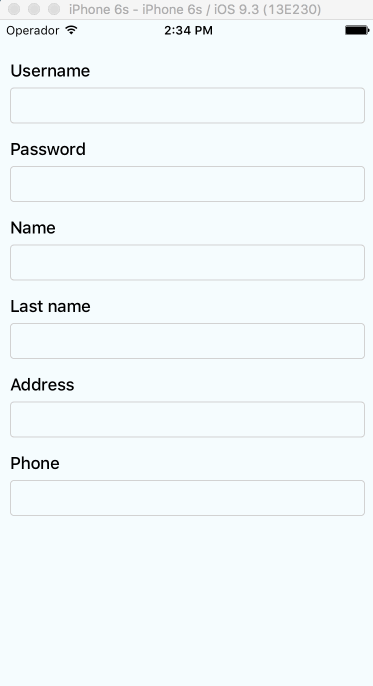A ScrollView component that handles keyboard appearance and automatically scrolls to focused TextInput.
v0.2.0requiresRN>=0.32.0.v0.1.2requiresRN>=0.27.2but you should use0.2.0in order to make it work with multiple scroll views.v0.0.7requiresreact-native>=0.25.0.- Use
v0.0.6for older RN versions.
Installation can be done through npm:
npm i react-native-keyboard-aware-scroll-view --saveYou can use the KeyboardAwareScrollView or the KeyboardAwareListView
components. Both accept ScrollView and ListView default props and
implements a custom KeyboardAwareMixin to handle keyboard appearance.
The mixin is also available if you want to use it in any other component.
Import react-native-keyboard-aware-scroll-view and wrap your content inside
it:
import { KeyboardAwareScrollView } from 'react-native-keyboard-aware-scroll-view'<KeyboardAwareScrollView>
<View>
<TextInput />
</View>
</KeyboardAwareScrollView>As of v0.1.0, the component auto scrolls to the focused TextInput 😎. For versions v0.0.7 and older you can do the following.
In order to scroll to any TextInput field, you can use the built-in method scrollToFocusedInput. Example:
_scrollToInput (reactNode: any) {
// Add a 'scroll' ref to your ScrollView
this.refs.scroll.scrollToFocusedInput(reactNode)
}<KeyboardAwareScrollView ref='scroll'>
<View>
<TextInput onFocus={(event: Event) => {
// `bind` the function if you're using ES6 classes
this._scrollToInput(ReactNative.findNodeHandle(event.target))
}/>
</View>
</KeyboardAwareScrollView>There's another built-in function that lets you programatically scroll to any position of the scroll view:
this.refs.scroll.scrollToPosition(0, 0, true)You can register to ScrollViewResponder events onKeyboardWillShow and onKeyboardWillHide:
<KeyboardAwareScrollView
onKeyboardWillShow={(frames: Object) => {
console.log('Keyboard event', frames)
}}>
<View>
<TextInput />
</View>
</KeyboardAwareScrollView>First, Android natively has this feature, you can easily enable it by setting windowSoftInputMode in AndroidManifest.xml. Check here.
But if you want to use feature like extraHeight, you need to enable Android Support with the following steps:
- Make sure you are using react-native
0.46or above. - Set
windowSoftInputModetoadjustPaninAndroidManifest.xml. - Set
enableOnAndroidproperty totrue.
Android Suppor is not perfect, here is the support list:
| Prop | Android Support |
|---|---|
viewIsInsideTabBar |
Yes |
resetScrollToCoords |
Yes |
enableAutoAutomaticScroll |
Yes |
extraHeight |
Yes |
extraScrollHeight |
Yes |
enableResetScrollToCoords |
Yes |
keyboardOpeningTime |
No |
All the ScrollView/ListView props will be passed.
| Prop | Type | Description |
|---|---|---|
viewIsInsideTabBar |
boolean |
Adds an extra offset that represents the TabBarIOS height. |
resetScrollToCoords |
Object: {x: number, y: number} |
Coordinates that will be used to reset the scroll when the keyboard hides. |
enableAutoAutomaticScroll |
boolean |
When focus in TextInput will scroll the position, default is enabled. |
extraHeight |
number |
Adds an extra offset when focusing the TextInputs. |
extraScrollHeight |
number |
Adds an extra offset to the keyboard. Useful if you want to stick elements above the keyboard. |
enableResetScrollToCoords |
boolean |
Lets the user enable or disable automatic resetScrollToCoords. |
keyboardOpeningTime |
number |
Sets the delay time before scrolling to new position, default is 250 |
enableOnAndroid |
boolean |
Enable Android Support |
| Method | Parameter | Description |
|---|---|---|
getScrollResponder |
void |
Get ScrollResponder |
scrollToPosition |
x: number, y: number, animated: bool = true |
Scroll to specific position with or without animation. |
scrollToEnd |
animated?: bool = true |
Scroll to end with or without animation. |
MIT.


